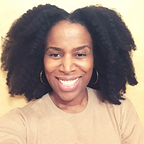Color 101, Racial Identity and an Argument with My Kindergarten Teacher
I was first introduced to the idea of racial identity in kindergarten back in the mid-70s, and it began with an argument with my teacher.
Miss Grey, a tall, thin woman with skin the color of dark chestnuts and poofy hair just like mine, stood before our finger paintin’, lunchbox totin’ class of 5-year-olds and announced with a sincere smile, that we were all black.
What…was this woman talking about?
I remember where I sat that day, and how I struggled with processing what my new teacher was telling me. Black? I looked down at my hands and then back up at her and raised my hand quickly.
“Miss Grey,” I said with the all-knowing confidence that only a 5-year-old could pull off, “I’m not black, I’m brown.” I then poured out my little box of crayons and placed the brown one next to the black one and continued, “See,” as I put the brown one next to my skin and lifted my hand up for her to inspect up close. “I am brown like this crayon, not black.”
Obviously, this teacher had failed Color 101, and I was more than happy to explain it to her.
The idea of color and race was new to me because I’d just moved back to Atlanta, Georgia (my birthplace) from Anchorage, Alaska, where I’d lived on a military base since before I could speak. So, during the most formative years of my brain’s development, I was in a melting pot of kids who looked nothing like me or like each other for that matter. Our only common denominator was that our parents served in the military.
We didn’t talk about race. As kids, that didn’t matter to us. We just wanted somewhere to belong. My kinky afro-textured hair was just as fascinating to my afterschool hangout buddy as her wavy ginger-colored hair and freckles were to me.
Four and five-year-olds don’t grapple with what the other person might be thinking about their skin color unless they’ve been taught that there’s a fundamental difference. It’s only then that the paranoia and questions begin.
Like most people who look like me, I know what it feels like to be judged based on my skin color. But, instead of going back to that day in kindergarten when I felt the first sting of knowing that I could be lumped into a generic color category, I go back a little bit further. I choose to remember the time I sat on our back porch in Alaska, arm in arm with my white friend watching snow crabs crawl around in the grass.
While there will always be someone willing to scream our differences from the mountain top, as adults, we have a great opportunity to define for our kids what those differences “do” and “do not” mean. I’m sure my kindergarten teacher had a good reason for telling us that we were black that day, but I can tell you that I was one confused child.
Almost 50 years later, I still struggle with the labels, especially as I try to teach my children how to tune them out. I’m still that confused little girl asking what color has to do with anything and politely requesting that if you’re going to label me with one, at least offer me more than 5.
I am grateful that I have more than one reference point to inform my response to our world’s fascination with color. Feeling “different” impacts the choices that we make in life, and life is hard enough without having some arbitrary category floating around in the back of your head.
While the reality is that we are often defined by subjective rules that weave seamlessly through the hues of our world’s color spectrum, the world’s color lines are beginning to blur, and so are the invisible color labels stamped on our foreheads.
Race is a funny thing. As children, we’re fascinated by it, but as adults, we use it as a weapon. Life would be a lot more interesting if we could just pick our favorite color and jump in the crayon box together.
